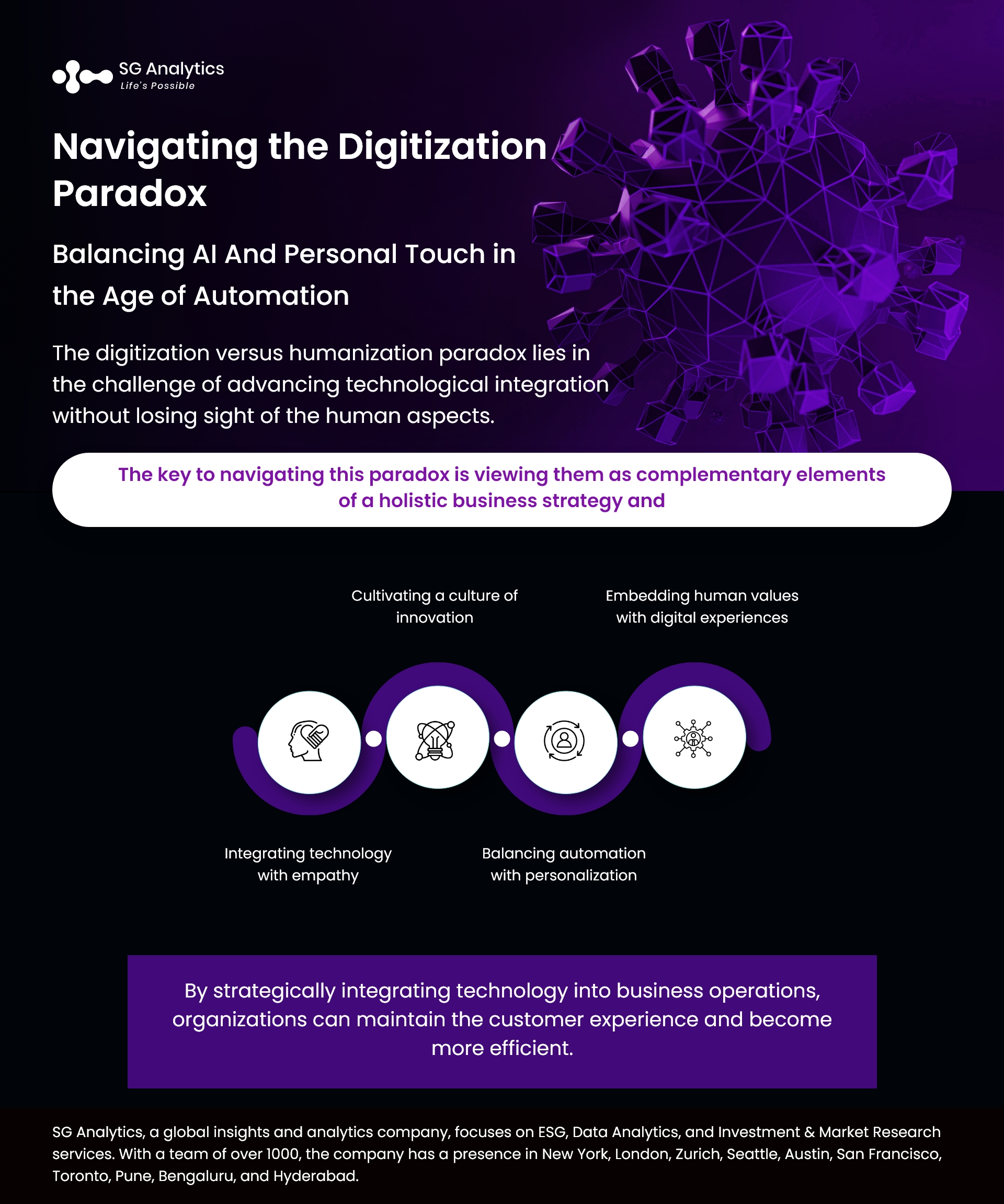Automation in customer service has exploded across businesses.
It has been challenging for organizations to provide exceptional customer service with the assistance of AI. Technology has improved customer service efficiency, but business owners and leaders need to remember that human interaction between company and customer is critical in business and fostering long-lasting relationships.
The digitization versus humanization paradox helps in portraying the critical tension organizations often face when navigating today's business landscape. This paradox stems from the simultaneous need to embrace digital technologies to enhance efficiency and foster innovation while recognizing the integration of human elements like empathy, creativity, and personal connection - vital for customer experiences and employee engagement.
However, one question still prevails: How can organizations embrace the advancements of digitization along with artificial intelligence without losing the essence of human connection across business operations?
Read more: Unlocking The Potential of Generative AI to Enhance Customer Experiences
Driving Efficiency and Innovation with Digitization
Digitization encircles the incorporation of digital technologies across all areas of a business, fundamentally changing how data operations are conducted and value is delivered to customers. It encompasses components ranging from automation and data analytics to artificial intelligence (AI) and blockchain. This growing drive towards digitization is motivated by the need to achieve greater efficiency and scalability, along with the ability to innovate rapidly as per the changing market dynamics.
Organizations that can successfully integrate digitization are better equipped to process accumulated data more quickly, reduce operational costs, and design new solutions at pace. They are better equipped to analyze new market trends, personalize customer interactions, and optimize their operations. In essence, digitization presents a path to enhanced competitiveness and agility.

Navigating the Essence of Connection with Humanization
Humanization focuses on the preservation and enhancement of human-centric experiences within business operations. This involves fostering genuine connections while also ensuring personalization in customer interactions and valuing employee well-being. Humanization further emphasizes the need to build trust and nurturing relationships.
Today customers and employees are intertwined together for authentic connections and experiences. Organizations that prioritize humanization can cultivate loyalty, enhance employee satisfaction, as well as create a brand reputation that sets them apart.
Read more: Navigating the Future of Marketing with AI-Powered Solutions
Navigating the Paradox
The digitization versus humanization paradox lies in the challenge of advancing technological integration without losing sight of the human aspects. The key to navigating this paradox is viewing them as complementary elements of a holistic business strategy.
- Integrating Technology with Empathy: Leveraging tech will help enhance human interactions. AI equips businesses to offer personalized customer services while ensuring that human support is accessible.
- Cultivating a Culture of Innovation: Encouraging a culture that values technological innovation for employee well-being and development is critical for successful digital transformation.
- Balancing Automation with Personalization: Utilizing automation to streamline operations requires human intervention and creativity.
- Embedding Human Values with Digital Experiences: Designing digital interfaces that are inclusive and reflective of human values will help ensure that technology will help enhance user experience.
Today, the digitization versus humanization paradox presents both a challenge and an opportunity for organizations. By carefully integrating digital technologies with a commitment to the human touch, organizations can harness the power of both and nurture a future that is technologically advanced and also profoundly connected.

Integrating Best Practices to Cultivate Human-Centric Automation
Data is an organization's most critical resource. It enables them to make informed decisions, offers critical insights into their customers, and helps create operational efficiencies to lower costs and higher margins. By cultivating a healthy data architecture, organizations can feed the right data into the algorithm throughout their lifecycle for informed decisions. The final goal is to ensure optimal results. However, these algorithms are only as useful as the data that is fed into them.
Read more: Google Search and Generative AI: Navigating the Paradigm Shift
It is, therefore, important to ensure the accuracy, reliability, integrity, and confidentiality of the data. And this can be achieved when a human touch is always present throughout the autonomous decision-making. This enables automation to align with corporate values, ensures optimal outcomes, and keeps the machines that generate them fair. To ensure the human touch, organizations should start with the following.
-
Ensuring Data Quality
When data moves through a system, it gets accessed, updated, and combined with other records, and any errors that exist in the initial entry will be exponentially exacerbated. To prevent this, it is vital to embed the data structures with human-led data quality checks. This will help detect and correct errors as the data is ingested and constantly monitor it as it is accessed and used.
-
Making Data Accessible to All
Ensuring the right data is accessible for the right applications is important. If the algorithm processes only a fraction of the relevant data, it is likely to produce biased results. A healthy data architecture never imposes any artificial caps on data consumption. Rather, it helps ensure that all relevant data is fed into decision-making computations.
For organizations to run their operation efficiently, there are many components at play. Organizations need to incorporate four strategies that can enable them to maintain the highest level of human-centric automation:
- Training the technology team to employ empathy when training AI algorithms to interact with human customers.
- Training the staff to use AI as a supplement to their job, but not just allow the technology to run unmonitored entirely.
- Seeking guidance from a human customer service specialist when problems cannot be quickly resolved using AI.
- Minimizing wait times when humans interact with the customer service team.
While the integration of smart technology moves at light speed, it is critical for business leaders and owners to navigate the changing landscape at the same speed. By integrating technology into business operations in a strategic way, organizations can maintain the customer experience and allow businesses to become more efficient.
Read more: Harnessing the Power of Data to Transform Business Models and Drive Growth

Fostering Human-led Governance for Growth
Machines do not have ethics or morals and can't make any judgment calls. This can lead to biases due to distorted data insights. If left alone, these models can unintentionally shift due to the influence of outside factors and can lead to unintended and undesired results. An algorithm might not be able to differentiate whether a given dataset contains personally identifiable information (PII). And this data breach could prove a catastrophe for a business and its customers.
In machine learning, AI helps in creating and training algorithms without human intervention. Ethical AI further helps ensure that machines operate according to moral principles. Due to this reason, AI models must be continually monitored, measured, and recalibrated.
Having humans train algorithms is a win-win, it can help in identifying and teaching edge cases for machines. It is therefore vital for organizations to have clearly articulated, reliably documented data that is regularly updated along with consistently enforced policies for securing sensitive data and ensuring regulatory compliance.
A leader in the Technology domain, SG Analytics partners with global technology enterprises across market research and scalable analytics. Contact us today if you are in search of combining market research, analytics, and technology capabilities to design compelling business outcomes driven by technology.
About SG Analytics
SG Analytics (SGA) is an industry-leading global data solutions firm providing data-centric research and contextual analytics services to its clients, including Fortune 500 companies, across BFSI, Technology, Media & Entertainment, and Healthcare sectors. Established in 2007, SG Analytics is a Great Place to Work® (GPTW) certified company with a team of over 1200 employees and a presence across the U.S.A., the UK, Switzerland, Poland, and India.
Apart from being recognized by reputed firms such as Gartner, Everest Group, and ISG, SGA has been featured in the elite Deloitte Technology Fast 50 India 2023 and APAC 2024 High Growth Companies by the Financial Times & Statista.









